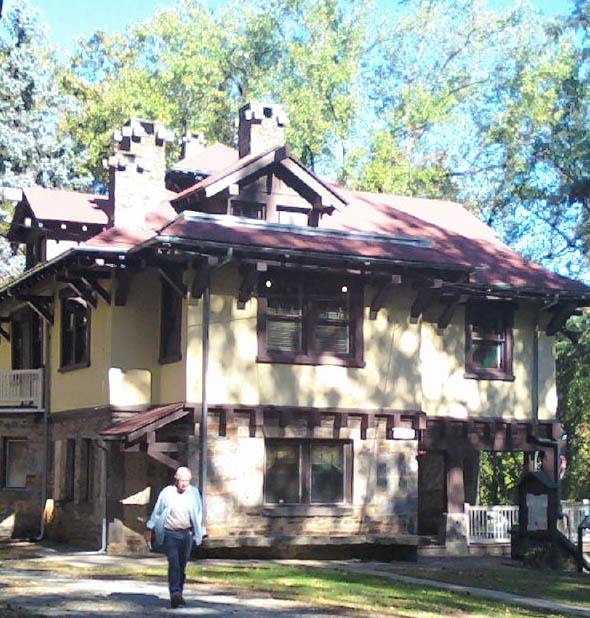And so it came to pass after all these years, that once more a trip to Indian Steps Museum near Airville was made. In some ways it seemed different than the last time I attended the annual ‘copperhead round-up’ where the late Dr. Josiah ‘Joe’ Hunt held forth as the main man.
Back then, in the mid-seventies, the gathering of all kinds of snakes with Indian Steps being the staging area was a big deal. Water snakes, black rat snakes, garter snakes, and every now and then an Eastern Diamondback rattler were caught along with many sizes of copperhead.
The only snake ever put down was a water snake, so I was told, all the rest were released back into their native habitat. Word also had it that many were not released, but were taken from the area, a behavior that I was also told, led to the discontinuance of the annual round-ups.
Nonetheless, long beore the copperhead round-ups my grandmother Addie Holden would insist on a trip there with my grandfather, Ches Holden, and any assortment of ladies Addie could round up like Ruby Butler, Myra Yerkes, Alice Bennington or Gertrude Orr. Not many men accompanied grandma and me on these sorties to the river.
We would picnic along the shore near the museum and take in the entire day, wandering about, seeing all kinds of flora and fauna. The place was both mysterious and magical at the same time to me. The legend of how it came to be never entered my mind then.
It really didn’t matter to a kid of 9 who was responsible, no more than the guy who made Hershey Park was it was back then.
Later on in life, when I wrote a story about the ‘steps’ for the Aegis, I learned the principle tribe which inhabited the area was the Susquehannocks, whose bearing and size impressed Capt. John Smith in 1608 and whose greatest period extended from 1605 to 1695. Before then it was the Algonquians, as all tribes came to this sacred ground because of the river and the fruits it provided.
The last Indians residing along the Susquehanna were Shawnees, and they lived at Indian Steps. Finally, when only 18 of them remained, they departed westward in 1765. Story is the last seen of any of them was when the chief and his daughter climbed into a canoe and paddled down river. (As stated in the tour guide for the museum).
The current building was noticed by John Edward Vandersloot, York, and he amassed a huge collection of arrows and spear heads, stone axes and other relics found there. He then embedded the relics into the walls. He literally ensconced all the relics into the house.
Over the doorway to the museum are the words, “I entreat all those who pass this way to safely guard and preserve these former possessions of and monuments to an ancient Indian people. John Edward Vandersloot, Owner and Builder, Indian Steps cabin-1912.”
And so it is today a sacred place to set foot on. Much of the wonderment of this boy who went there over 60 years ago with his grandmom, still today holds that same charge of sanctity in the air. Birdlife and overall tranquility abound for anyone taking the time to visit.
On this day, Danny McLaughlin came with me and we each spent more time than ever before inside the museum, on each of the three levels, taking in more this time and learning more.
It was good to visit this place again. It was new and old at the same time. Obviously, when the copperhead roundups were in full swing I had little time to spend inside as I did on this last visit. The crowds, the snakes and of course Joe Hunt made that special chapter of Indian Steps powerful in their own right.
Today it’s more nostalgia and yet new experiences and understanding of just how much one man’s dreams became a monument for a vanishing race.
Entering Indian Steps, one is taken by the austere landscaping and the ponds along the yard. To the east is the Susquehanna River. Over 60 labeled species of trees are found nearby.




Interesting. What is the story of the snake roundups? I’d never heard of that.
i was informed by Jim Chance that the rattlers found back in the days of the ’round-ups’ were likely timber rattlers, not diamondbacks, which normally only venture as far north as North Carolina.
I was always told the last of the Susquehannocks were murdered by the Paxtang Boys, an angry white mob that broke them out of protective custody to do so.
from Wikipedia…
The Paxton Boys marched toward Philadelphia in January of 1764 with about two-hundred and fifty men. They met with civic leaders in Germantown and after it was agreed they could print a pamphlet and it would be read before the legislature they agreed to disperse.
After the November killings there was general agreement that the murders had been acts of total cowardice. The country people involved were more savage than the Indians themselves. The most influential response was Ben Franklin’s Narrative of the Late Massacres which ended by noting that the Conestogas would have been safe among any other people on earth, no matter how primitive, except “the CHRISTIAN WHITE SAVAGES of Peckstang and Donegall!’